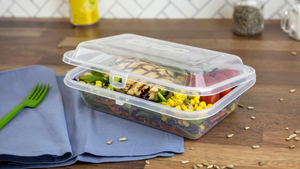Moldmaking: StackTeck's technology helps lighten even lightweight parts
Canada’s StackTeck, a manufacturer of specialty, high-production molds, announced a new patent-pending technology, called TRIM (Thin Recess Injection Molding), for light-weighting injection molded parts. The announcement was made in a presentation, ‘Plastic Part Design and Prototyping for IML Applications,’ by Jordan Robertson, StackTeck’s general sales manager, at the IMLCon ‘08 North America conference, held in Phoenix, AZ on Oct. 22-24. MPW attended the event.
November 21, 2008
TRIM entails both the design and processing of a part. Conventional thin wall part design normally assumes a maximum low length/average wall thickness (L/T) ratio of 300. Using TRIM, Stackteck has demonstrated, using a 32 oz. rectangular container design, that large areas of the part can be thinned out so that these have an L/T ratio greater than 500. Depending on part shape and design, weight savings using this technology could be in the range of 20-40%.
StackTeck’s President, Randy Yakimishyn, said in a prepared statement, “Our customers are telling us that light-weighting is more important than ever, and so we are continuing to advance the forefront of this technology. At this point, we believe that we can achieve part weights that will make injection molding much more competitive against thermoforming, while maintaining key functional features such as the tamper evident rim on a container and high top-load compression strength.”
The prototype parts had a flow length of 5.74 inches (14.57 cm) and, with the recess areas covering half of the part’s side wall and bottom, a panel thickness of 0.011 inches (0.28 mm) was achieved. The injection speed and pressure used to fill the part were normal, by thin wall packaging standards, and Stackteck expects thin wall molders can adopt this technology using existing injection molding machines. This maybe is the biggest news of the development; L/T ratios of greater than 300 have been achieved before, including by StackTeck, but these have always involved machines able to generate tremendous speed and pressure. A fill time of 0.2 second was achieved at a moderate fill pressure, using a 35MFI polypropylene supplied by LyondellBasell.
“Designing this part took a huge amount of flow modeling,” Robertson pointed out in his presentation. “With wall thickness that is one-half the standard thickness and covers one-half of the surface area of the part, we expected to have holes, but the model told us we wouldn’t – and we didn’t.” The TRIM technology is being showcased on StackTeck’s IML pilot cell at the company’s facility just north of Toronto International Airport, using a 330-tonne injection molding machine. The IML pilot cell is a joint effort by StackTeck, Netstal, and CBW Automation to provide a prototyping and pilot program vehicle to the industry for IML applications.
About the Author(s)
You May Also Like


